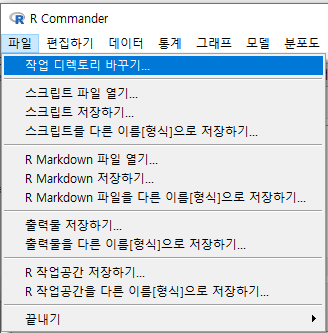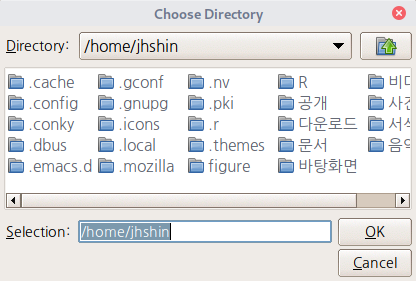파일 > 스크립트 다른 이름으로 저장하기...
File > Save script as...

작업한 스크립트 파일을 다른 이름으로 저장한다. 기본으로 설정된 파일 이름은 RCommander.R이다. 이름을 원하는 것으로 변경한다.
만들어서 불러왔던 원래의 스크립트 파일 이름이 LMM.R 이었다. 이것을 LMM_1.R로 바꾸는 과정이다.

R Commander의 맨 아래에 있는 알림글에 관련 사항이 기록된다.

파일 > 스크립트 다른 이름으로 저장하기...
File > Save script as...

작업한 스크립트 파일을 다른 이름으로 저장한다. 기본으로 설정된 파일 이름은 RCommander.R이다. 이름을 원하는 것으로 변경한다.
만들어서 불러왔던 원래의 스크립트 파일 이름이 LMM.R 이었다. 이것을 LMM_1.R로 바꾸는 과정이다.

R Commander의 맨 아래에 있는 알림글에 관련 사항이 기록된다.

파일 > 스크립트 저장하기...
File > Save script...

R Commander의 입력창에서 작업한 내용을 .R 파일 형식으로 저장한다. 저장하는 작업공간을 선택 또는 변경할 수 있다.
RCommander.R이 기본설정으로 스크립트 이름이 나온다. 원하는 이름으로 변경하여 사용하자.
파일 > 스크립트 파일 열기...
File > Open script file...

.R 형식의 스크립트 파일을 만드는 것은 R을 사용하는 데이터과학자의 일반적인 활동이다. 때로는 길게, 때로는 짧게 .R 파일들을 만든다. 저장된 파일을 다시 불러서 추가적인 작업을 하거나, 코드를 고치거나, 때로는 다른 사용자가 만든 .R 파일을 불러와 작업을 하는 것이 흔하다.
.R 파일은 일반적으로 문서 편집기로 작업을 할 수 있다. R Commander는 입력창과 출력창을 나눠서 작업이 가능하기 때문에, 입력창을 문서 편집기처럼 활용해서 .R 파일을 작업할 수 있다.
LMM.R 이라는 스크립트를 만들고, 저장했다고 가정하자. R Commander를 시작하고, 경로에서 이 스크립트를 찾아 불러오는 과정이다.

입력창에 스크립트의 내용이 등장한다.

위의 스크립트를 보면, sleepstudy 라는 데이터셋이 호출되고, lmer() 함수를 사용한 LMM.1이라는 모형이 만들어진다. '파일 > 스크립트 파일 열기...' 메뉴 기능은 스크립트를 선택하고 기록을 불러오는 것이지, 내용을 실행하는 것은 아니다. 스크립트를 실행하려면, 해당 부분을 선택하고 블록을 씌우고 <실행하기> 버튼을 눌러야 한다.
그리고나서, R Commander 상단 메뉴에 있는 < 활성 데이터셋 없음 >, < 활성 모델 없음 > 버튼을 각각 누르면 sleepstudy, LMM.1이라는 데이터셋과 모형을 선택할 수 있다. 선택하면 화면 상단에 '데이터셋: sleepstudy', '모델: LMM.1'이 표시된다.

파일 > 작업 디렉토리 바꾸기...
File > Change working directory...

R이 시작되는 곳, 불러올 데이터가 보관되는 곳, 그리고 데이터를 저장할 곳이 다른 경우가 흔히 발생한다. 흔히 '경로' 변경과 관련된 일인데, 일일이 수작업으로 입력하기가 불편하다. GUI 환경에서 R 작업을 할 때, 효과적인 영역이다.
- MS-Windows 경우, user > 문서 경로부터 화면이 시작된다.
- Linux 경우, home/사용자 경로부터 화면이 시작된다.

관련된 함수는 getwd(), setwd() 등이 있다.
?setwd # 작업 디렉토리 (변경)설정 도움말 보기| getwd {base} | R Documentation |
getwd returns an absolute filepath representing the current working directory of the R process; setwd(dir) is used to set the working directory to dir.
getwd()
setwd(dir)
| dir | A character string: tilde expansion will be done. |
See files for how file paths with marked encodings are interpreted.
getwd returns a character string or NULL if the working directory is not available. On Windows the path returned will use / as the path separator and be encoded in UTF-8. The path will not have a trailing / unless it is the root directory (of a drive or share on Windows).
setwd returns the current directory before the change, invisibly and with the same conventions as getwd. It will give an error if it does not succeed (including if it is not implemented).
Note that the return value is said to be an absolute filepath: there can be more than one representation of the path to a directory and on some OSes the value returned can differ after changing directories and changing back to the same directory (for example if symbolic links have been traversed).
list.files for the contents of a directory.
normalizePath for a ‘canonical’ path name.
(WD <- getwd())
if (!is.null(WD)) setwd(WD)